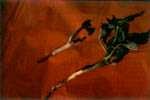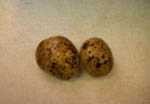Rhizoctonia disease Rhizoctonia solani occurs wherever potatoes are grown. The fungus survives in soil, plant debris and as black structures (sclerotia) on the surface of potato tubers.
Rhizoctonia / Black Scurf

Rhizoctonia infection can occur from planting to harvest. The fungus may cause poor emergence, brownish root, stem or stolon cankers, swollen stems, aerial tuber formation, leaf rolling, purpling of upper leaves, premature death of vines and tuber malformations. Signs of the fungus are evidenced by sclerotia (black scurf) on potato tuber surfaces and a white felt-like fungal growth covering on stems at the soil surface.
The disease is most severe under cold, wet soil conditions. Plants can become infected at any stage of growth. Sprouts may be killed or weakened, resulting in misses or late emergence and in weak plants with many stems. Depending on the stage of growth, plants may be stunted, late maturing, and/or the upper leaves may roll upward and turn slightly purplish. Aerial tubers may also develop. Often reddish-brown lesions may be seen on underground parts of stems and on stolons. Severely infected plants may produce small or misshapen tubers. Towards the end of the growing season, one can often see grayish-white powdery masses at the bases of stems just above the soil line.

The black scurf stage, also caused by Rhizoctonia solani, can be seen on infested tubers as small, black bodies (sclerotia) which are the resting stage of the fungus. These sclerotia may or may not serve as sources of the disease when the tubers are used as seed but do not present a danger in storage. Sclerotia germinate and/or mycelium infects emerging potato sprouts, roots, stolons, and tubers as they develop through the growing season. Pathogenic Rhizoctonia populations may survive for long periods in potato fields by infecting or saprophytically infesting other crops
Control
Whenever possible, use black scurf-free seed and plant in soils that have not grown potatoes or any other solanaceous crop for the last three years. Top pulling to remove below ground stems, stolons and roots can reduce sources of the fungus. Early harvest dates limit exposure periods of tubers to the pathogen. Avoid planting in cold, wet soil. Cover seed pieces with not more than 5 cm of soil to allow warming by the sun and quick emergence.
The number of sclerotia can be reduced by harvesting as soon as tubers are mature. Practice a crop rotation with cereals and grasses. Avoid a rotation with buckwheat before potatoes as Rhizoctonia colonizes mature buckwheat stems.
Use post-harvest fungicide treatments (see Publication No. 1300A). Fungicidal seed treatments are effective for seed-borne inoculum but not in heavily infested soils that have grown potatoes in the last few years. Fungicides must be applied to tubers free of soil to ensure adequate disease control. Soil treatment can also be effective but is very costly.
